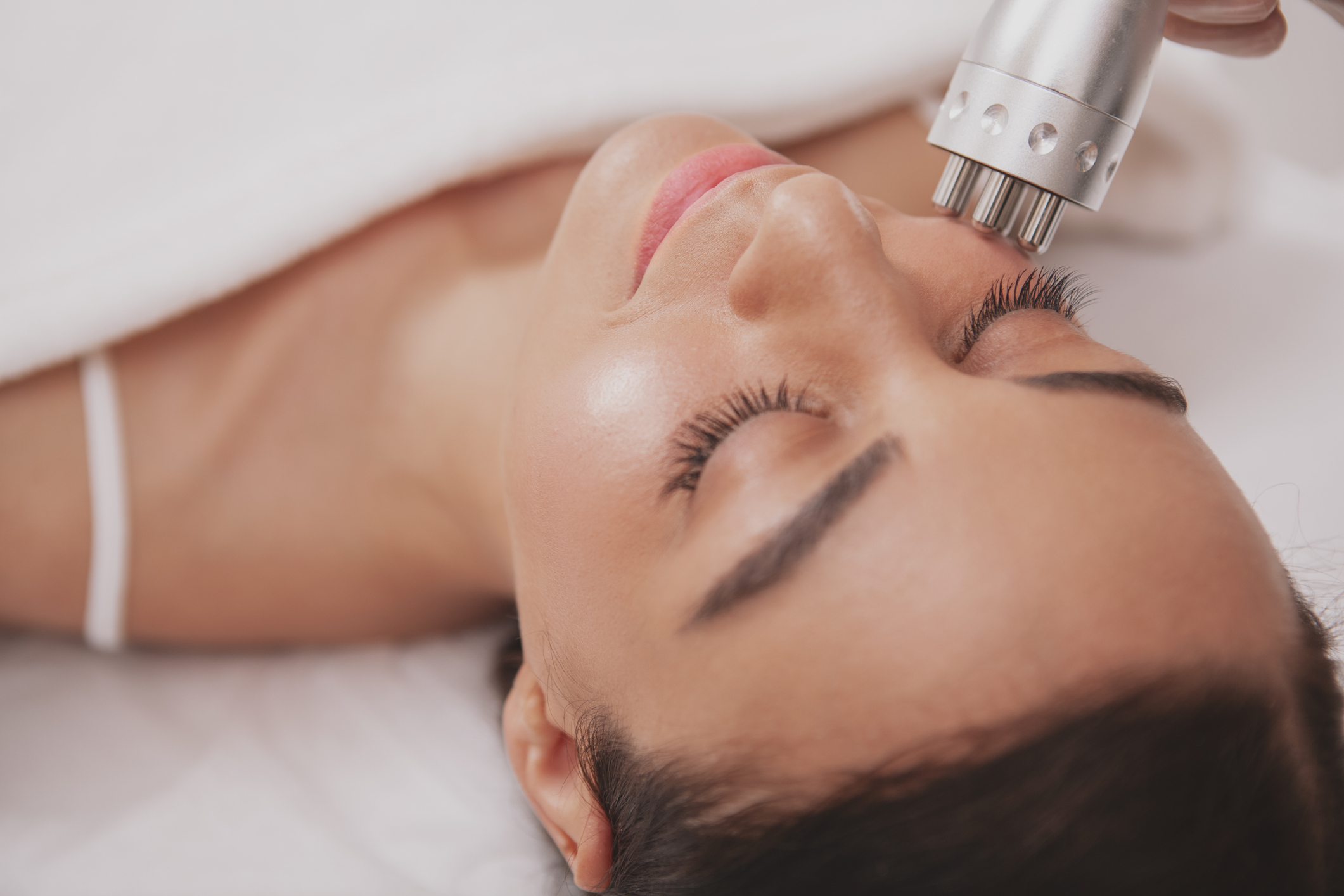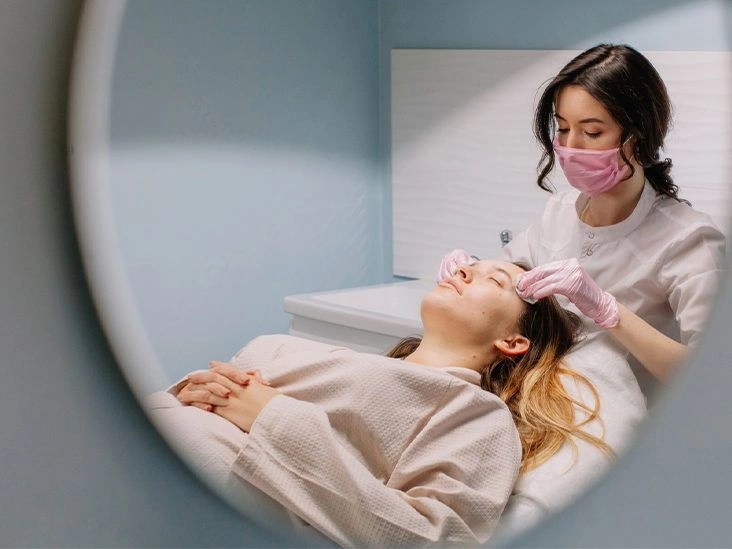Nonsurgical skin tightening treatments are cosmetic procedures aimed at improving the appearance of your face and abdomen. They’re considerably less invasive than surgical options such as facelifts and abdominoplasties, and some patients report comparable improvements. These approaches typically carry fewer risks, cost less, and involve minimal recovery time.
These therapies rely on more recent technologies, which means the evidence base is still developing. As a result, there remain unanswered questions about their overall effectiveness and potential long-term effects.
This article reviews the various noninvasive skin-tightening options, summarizes the available research, and highlights factors to consider before pursuing treatment.
Types of skin tightening treatments
At birth, skin is rich in structural proteins like elastin and collagen that provide resilience and firmness. With age, production of these proteins declines, and skin loses some of its elasticity.
Gravity, environmental pollutants, stress, and the repetitive motions of facial muscles can all contribute to skin appearing lax or sagging. Life events such as pregnancy and significant weight loss also often lead to stretch marks and loosened skin.
Noninvasive skin tightening methods focus on areas of lax skin and work to stimulate collagen regeneration beneath the surface. Broadly, these treatments fall into two categories:
- in-office procedures performed by a qualified clinician
- consumer at-home devices intended for self-treatment
In-office skin tightening procedures
Radiofrequency (Thermalift, Thermage, and Exilis)
Thermalift introduced the idea of stimulating dormant collagen to restore firmness. It applies controlled radiofrequency energy to targeted areas of skin. The procedure typically uses topical or no anesthesia, and there is no required downtime.
Thermage generally involves a single session for many patients, though some people opt for repeat treatments. Other radiofrequency protocols often call for multiple visits to achieve results. Whether one session or several are performed, improvements are modest immediately and tend to fully develop over about four months.
Intense pulsed light/radiofrequency (Velashape)
Velashape is a system that claims to reduce localized fat while tightening skin. The handheld device delivers infrared energy into skin layers to help break up fat accumulations, while also incorporating radiofrequency energy.
No anesthesia is usually required, and a series of appointments is commonly recommended to achieve the most noticeable outcome.
At-home devices
Ultrasound therapy
Ultrasound skin-tightening devices emit focused ultrasound waves into deeper skin layers to encourage collagen formation. Handheld versions of this technology are available for purchase online and at some beauty retailers.
These tools can be costly and require ongoing use to maintain any benefit. Without a trained clinician’s expertise, it can be difficult to achieve satisfactory results with consumer devices.
For the face
All of the treatments discussed here are cleared for use on the face, neck, and abdomen. Thermage, Thermalift, and Exilis are commonly used for facial rejuvenation. While Velashape can be applied to the face, it’s more frequently used for larger body regions.

For the stomach
The abdomen presents a larger treatment surface than the face and is more susceptible to stretch marks and sagging. Although Thermage, Thermalift, and Exilis can be used on the face, Velashape is typically recommended more often for abdominal areas.
Does it work?
The available research on noninvasive skin-tightening indicates these treatments can be effective. Results aren’t as pronounced as those from more aggressive interventions like laser resurfacing or surgery, but studies generally show measurable tightening.
A review of the medical literature on radiofrequency-based techniques reported that 96 percent of studies documented significant effects. However, the review also noted that many studies had methodological flaws that could introduce bias.
A small 2011 study suggested radiofrequency reduces facial wrinkles, though its sample size was very limited (six participants), which weakens the strength of the findings.
Another study found a consumer radiofrequency device to be safe and effective, but that research was also small, limiting the robustness of its conclusions.
More recently, a study involving 25 participants reported that radiofrequency-based skin-tightening approaches were effective after five to eight sessions, and participants expressed high satisfaction with their results.
Pictures
Below are examples of before-and-after images from in-office, noninvasive skin-tightening treatments.
- Thermage on the stomach from Naficy Plastic Surgery and Rejuvenation Center.
- Velashape on the stomach from Spalding Drive Plastic Surgery.
- Exilis on the face from DelRay Dermatology and Cosmetic Center.
Side effects
Side effects from these treatments tend to be mild to moderate and may include:
- swelling
- bruising
- redness
- tingling
- soreness
Rarely, skin burns can occur. Choosing a licensed, experienced practitioner substantially lowers the likelihood of significant complications.
Costs of tissue tightening
Noninvasive skin tightening is typically considered elective cosmetic care, so insurance generally won’t cover it; you should expect to pay out of pocket.
Radiofrequency treatments often start around $200 per session for abdominal and other body areas. Because multiple sessions are usually necessary, total costs frequently range between $800 and $2,000.
In 2018, the American Society for Aesthetic Plastic Surgery reported an average price for nonsurgical fat reduction procedures of about $1,559.
At-home options aren’t necessarily inexpensive. Consumer radiofrequency and ultrasound devices typically begin near $450, and many models cost more.
Surgical alternatives for skin tightening
Surgical options are more invasive but produce more dramatic, immediate, and long-lasting results. Facelifts and abdominoplasties deliver pronounced changes but require lengthy recovery periods. If you want permanent and clearly visible outcomes, surgery may better meet your expectations.
Surgery carries distinct risks and downtime that nonsurgical methods do not. Nonsurgical approaches usually need no recovery time and pose minimal infection risk, whereas surgical procedures involve potential infections and other complications.
Liposuction is another surgical option for the abdominal area. While less extensive than a tummy tuck, liposuction can reduce abdominal fat but may leave the skin appearing irregular or loose where fat was removed.
Where to find a provider
If you’re thinking about nonsurgical skin tightening, consult a qualified provider. A good starting point is the American Society of Plastic Surgeons directory to locate a cosmetic surgeon in your area.
The bottom line
Nonsurgical skin tightening offers a lower-risk alternative to surgical procedures. Evidence on their effectiveness is limited, and treatment can be costly.
Maintaining realistic expectations and choosing a licensed, experienced clinician are essential steps before undergoing these treatments.


















Leave a Reply
You must be logged in to post a comment.